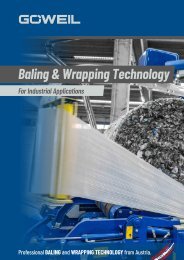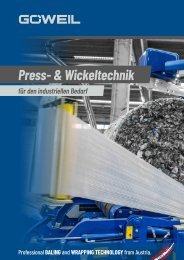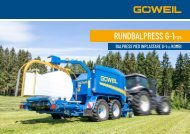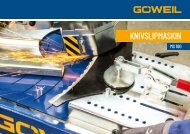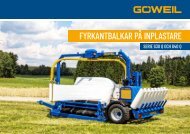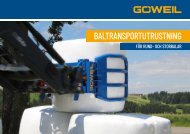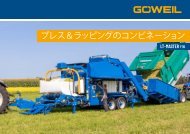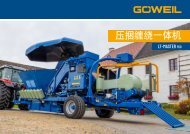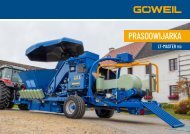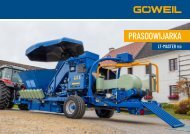EN | Baler-Wrapper Combination | LT-Master F115 | Goeweil
With the LT-Master F115, GÖWEIL is presenting an overhauled model of the tried-and-tested baler-wrapper combination. In addition to the state-of-the-art design, the silage baler impresses with a range of innovations that offer operators greater convenience and flexibility when using the machine.
With the LT-Master F115, GÖWEIL is presenting an overhauled model of the tried-and-tested baler-wrapper combination. In addition to the state-of-the-art design, the silage baler impresses with a range of innovations that offer operators greater convenience and flexibility when using the machine.
Create successful ePaper yourself
Turn your PDF publications into a flip-book with our unique Google optimized e-Paper software.
BALER-WRAPPER COMBINATION<br />
<strong>LT</strong>-MASTER <strong>F115</strong>
GÖWEIL<br />
MASCHIN<strong>EN</strong>BAU GMBH<br />
The name Göweil has been synonymous with the highest quality product range in the bale wrapping and baling technology sector since<br />
1988.<br />
Other core areas include the manufacture of bale opening and transport devices, high lift buckets as well as blade sharpeners.<br />
MECHANICAL <strong>EN</strong>GINEERING AT THE HIGH-<br />
EST LEVEL<br />
Professional solutions for the agro-industrial sector<br />
As an exceptionally high portion of its products are exported, GÖWEIL machines<br />
have become renowned and are widely used throughout the world.<br />
The company originally specialized in the production of agricultural machines, but<br />
its machines are now also available for industrial use.<br />
GÖWEIL is characterized by the following four values:<br />
QUALITY.<br />
All products are designed, developed,<br />
and produced at the company's sites<br />
in Kirchschlag and Rainbach (Upper<br />
Austria).<br />
EFFICI<strong>EN</strong>CY.<br />
By continuously developing our<br />
product range, we offer high-quality<br />
and efficient solutions in keeping with<br />
the times.<br />
KNOW-HOW.<br />
Years of experience, as well as close<br />
cooperation between design and<br />
manufacturing, are the keys to our<br />
well-thought-out solutions.<br />
SERVICE.<br />
Even the best machine needs maintenance.<br />
Our service team is there for<br />
you and will take care of your request.<br />
Company locations in Kirchschlag (above) and Rainbach (below)<br />
2
OUR SOLUTIONS:<br />
BALER-WRAPPER COMBINATION<br />
<strong>LT</strong>-MASTER <strong>F115</strong><br />
INTRODUCTION 4 - 5<br />
<strong>LT</strong>-<strong>Master</strong> further development & new highlights<br />
SILAGING 6 - 7<br />
Definition of silage & optimal feed quality<br />
MATERIALS 8 - 9<br />
Overview of materials suitable for baling and wrapping<br />
THE HIGHLIGHTS 10 - 11<br />
Components & benefits of the <strong>LT</strong>-<strong>Master</strong> <strong>F115</strong><br />
SETUP & PREPARATION 12 - 13<br />
All about the workflow<br />
MATERIAL FLOW 14 - 15<br />
Depiction of the material flow<br />
EQUIPM<strong>EN</strong>T 16 - 22<br />
Basic model, additional equipment, technical data<br />
and required connections<br />
SERVICE 23<br />
About our GÖWEIL Service Team<br />
3
<strong>LT</strong>-MASTER <strong>F115</strong><br />
FURTHER DEVELOPM<strong>EN</strong>T<br />
The first version of the <strong>LT</strong>-<strong>Master</strong> was brought to the market in 2004. Initially developed as a "baler-wrapper combination for corn silage",<br />
the number of materials suitable for baling has risen enormously. The development team at GÖWEIL has responded to this change, optimizing<br />
several components and moving with the times. It is now time to introduce a new generation of baler-wrapper combinations:<br />
EXPERI<strong>EN</strong>CE COUNTS<br />
The high compression of the material, the rapid expulsion of air from the bales as well<br />
as a totally clean production process are crucial for ensuring the highest feed quality<br />
in silage bales.<br />
GÖWEIL guarantees exactly that with the new generation of the <strong>LT</strong>-<strong>Master</strong> <strong>F115</strong>.<br />
Each bale also forms a small unit that can be used as feed quickly and easily. Additional<br />
advantages include:<br />
• Easy and inexpensive storage and transport of round bales<br />
• Simple production of mixed feeds (TMR)<br />
• Corn silage usage in summer feeding<br />
VERSATILITY PROVIDES THE EDGE:<br />
Thanks to the unique and complete solution that GÖWEIL is offering in the form of the<br />
<strong>LT</strong>-<strong>Master</strong> <strong>F115</strong>,<br />
more and more finely chopped materials such as alfalfa, grain,<br />
sugar beet, and even waste and plastics can be processed into round bales. Compaction<br />
rates of between 30% and 70% can be achieved depending on the size and<br />
structure of the material.<br />
Customers now include not only contractors, but also large-scale agricultural and industrial<br />
enterprises.<br />
4
<strong>LT</strong>-MASTER <strong>F115</strong><br />
THE NEW <strong>LT</strong>-MASTER <strong>F115</strong><br />
With the <strong>LT</strong>-<strong>Master</strong> <strong>F115</strong>, GÖWEIL is presenting an overhauled model of the tried-and-tested baler-wrapper combination. In addition<br />
to the state-of-the-art design, the silage baler impresses with a range of innovations that offer operators greater convenience and<br />
flexibility when using the machine.<br />
THE NEW HIGHLIGHTS AT A GLANCE:<br />
Hydraulically powered bale chamber<br />
Unlike the predecessor model, the bale chamber of the <strong>LT</strong>-<strong>Master</strong> <strong>F115</strong> is powered<br />
hydraulically rather than mechanically. During the baling and binding process, it is now<br />
also possible to choose between four different speed levels.<br />
Multicrop feeder<br />
In order to better process the many different materials, the feeder has been equipped<br />
with a dosing drum.<br />
Dosing drum of the Multicrop feeder<br />
PROFI plus L handset<br />
The <strong>LT</strong>-<strong>Master</strong> <strong>F115</strong> is operated with the PROFI plus L handset. The user interface is<br />
structured intuitively and enables easy operation of the machine.<br />
The new PROFI plus L handset<br />
5
<strong>LT</strong>-MASTER <strong>F115</strong><br />
SILAGING<br />
In principle, all green forages can be processed into silage. In addition to grass silage, corn silage is the most commonly used feed in dairy<br />
cattle farming. While alfalfa and clover silages are very rich in protein, corn silage boasts the highest energy content next to grass silage<br />
due to the starch. The exact silaging sequence is explained here:<br />
INFO<br />
SILAGING<br />
The chopped mass is wrapped completely airtight and stored. The residual sugar from<br />
the chopped material and deoxygenation give rise to the process of lactic acid fermentation.<br />
The silage acidifies, which makes it keep well. Silage is a high-quality and<br />
important feed for livestock in particular.<br />
If the silage is too wet or contains too much residual oxygen, it can lead to undesirably<br />
high levels of acetic or butyric fermentation. This renders the silage inedible for livestock<br />
and brings with it the risk of sickness caused by toxic excretory products.<br />
Efficient silaging with the <strong>LT</strong>-<strong>Master</strong> <strong>F115</strong> baler-wrapper combination can eliminate<br />
multiple potential hazards:<br />
• Very high compression during the baling process means optimal keeping quality<br />
and the best-possible feed quality<br />
• Particularly fast air-tight seal through an optimized baling-wrapping process<br />
• Totally clean production process and therefore no feed impurities<br />
• No risk of secondary fermentation or subsequent warming<br />
6
OPTIMAL FEED QUALITY<br />
Every farmer wants to provide their animals with the best-possible feed. Using silage<br />
offers a number of benefits and has become virtually indispensable to modern feeding.<br />
In order to achieve first-rate silage quality, several factors need to be considered. The<br />
high compression of the feed is top priority along with a rapid air-tight seal and a<br />
clean production process. This is all combined to optimal effect by the <strong>LT</strong>-<strong>Master</strong> <strong>F115</strong>.<br />
A study by The Agricultural Research and Education Center Raumberg-Gumpenstein<br />
clarifies the difference between the compression of corn silage for bunker silos and<br />
round bales:<br />
kg DM/m³<br />
COMPRESSION OF CORN SILAGE<br />
INFO<br />
250<br />
239 239<br />
Significant differences can be identified in the density of corn silage:<br />
A<br />
B<br />
200<br />
Bunker silo 148 kg DM/m³ (9 lbs DM/ft³) 120 kg DM/m³ (7.5 lbs DM/ft³)<br />
Round bales 239 kg DM/m³ (15 lbs DM/ft³) 239 kg DM/m³ (15 lbs DM/ft³)<br />
150<br />
148<br />
Corn silage bales Standard Variable bale size<br />
Diameter 1.15 m (3’ 9”) 0.60 - 1.15 m (2’ - 3’ 9”)<br />
100<br />
120<br />
Width 1.20 m (4’) 1.20 m (4’)<br />
Weight (at 29% DM)<br />
~ 1,100 kg (880 kg/m³)<br />
(~ 2,400 lbs)<br />
~ 300 - 1,100 kg (880 kg/m³)<br />
(~ 660 - 2,400 lbs)<br />
Volume 1.25 m³ (44 ft³) 0.35 - 1.25 m³ (12 - 44 ft³)<br />
50<br />
Round bales A Bunker silo A Round bales B Bunker silo B<br />
Corn silage<br />
"For silage round bales, microbial group 2 is strikingly low (bacteria associated with spoilage:<br />
bacillus, micrococcus, coagulase-negative species of staphylococcus - orientation<br />
value: 200) with values of 6.0 - 6.5 CFU/g. This can be attributed to particularly rapid<br />
anaerobic storage."<br />
Source: LFZ Raumberg-Gumpenstein - Pöllinger 2011<br />
7
<strong>LT</strong>-MASTER <strong>F115</strong><br />
MATERIALS<br />
1<br />
The large variety of materials suitable for baling and wrapping means that the <strong>LT</strong>-<strong>Master</strong> <strong>F115</strong> can be used for a wide range of purposes. As a<br />
result of the various harvest times, the machine is used to capacity all year round. This guarantees maximum efficiency and utilization.<br />
The most common materials at a glance:<br />
4<br />
7<br />
1 CORN<br />
Corn silage is produced using the entire corn plant and serves as one of the most<br />
important staple feeds for livestock with high milk yields. Corn silage provides<br />
particularly nutritious energy in the form of starch from crushed corn grains and<br />
is also very rich in fiber. In this way, corn silage provides the optimal conditions<br />
for achieving maximum milk or fattening yields. Particularly at temperatures<br />
above 15 degrees Celsius, the feed can deteriorate in quality due to the high activity<br />
of microbacteria. The very high compression during the <strong>LT</strong>-<strong>Master</strong> <strong>F115</strong> baling<br />
process achieves unmatched keeping and feed quality.<br />
2<br />
CCM<br />
2<br />
5<br />
8<br />
CCM (corn-cob-mix) is an excellent energy feed made from the cob and kernels of<br />
the corn cob. It is used to feed pigs, cattle, and other small ruminants. CCM silage<br />
offers the maximum energy concentration through additional starch and has an<br />
excellent price-performance ratio in comparison with traditional concentrated<br />
feed. The crushing of corn grains gives the feed more structure and makes it very<br />
easy for livestock to pick up. Due to their compact shape, CCM silage bales are<br />
perfectly easy to handle and also ideally suited to feeding in smaller quantities.<br />
3<br />
6<br />
9<br />
3 ALFALFA<br />
Alongside corn silage, alfalfa silage is one of the most important basic feed components<br />
in cattle feeding. High feed intake as well as particularly high structural<br />
effectiveness contributes to substantial cattle milk yields. The cultivation of alfalfa<br />
offers high yield security and also improves the quality of the soil. However, its low<br />
sugar content makes alfalfa very difficult to preserve using traditional methods.<br />
Processing into round bales using an <strong>LT</strong>-<strong>Master</strong> <strong>F115</strong> significantly enhances the silage<br />
quality of alfalfa thanks to the rapid air-tight seal and effective compression.<br />
8
4<br />
SUGAR BEETS<br />
7 GRAIN WPS<br />
Compressed corn silage bales<br />
Pressed sugar beet pulp silages are characterized by a very high energy<br />
content, they are easily digestible, and impress with their palatability.<br />
They are an ideal supplement to grass silages since they have a negative<br />
ruminal nitrogen balance and thereby compensate for the protein balance<br />
in the stomach. Pressed beet pulp silages have very low lactic acid<br />
content and therefore also a very low total acidity. High compression as<br />
well as clean processing while still warm are hugely important for silage<br />
quality. <strong>LT</strong>-<strong>Master</strong> <strong>F115</strong> round bales also cool down faster and can therefore<br />
be used for feeding sooner.<br />
Cereal grain whole plant silages tend to be produced using barley, wheat,<br />
or triticale. Cultivation provides a very reliable yield and has benefits in<br />
the field of crop management. However, cereal grains have a very low<br />
energy content and is difficult to ensile using traditional methods. Optimal<br />
compression and the rapid air-tight seal make it easy to produce cereal<br />
grain silage with the <strong>LT</strong>-<strong>Master</strong> <strong>F115</strong>.<br />
Compressed CCM bales<br />
5 TMR – TOTAL MIXED RATION<br />
A TMR contains a balanced mix of staple forage and concentrated feed.<br />
Dry matter content and energy content are perfectly coordinated. TM rations<br />
have a very positive effect on milk yields and animal health. Already<br />
fermented silages are mixed and ensiled again for stockpiling TMR. The<br />
<strong>LT</strong>-<strong>Master</strong> <strong>F115</strong> can be used to produce TMR inventory quickly, easily, and<br />
inexpensively. It is transportable and therefore an ideal solution for trade.<br />
8<br />
GRASS<br />
Grass silage serves as the most important staple forage for livestock. The<br />
feed is made from an optimal combination of sweet grasses, herbs, and<br />
clover. Grass types with a high sugar content guarantee a good fermentation<br />
process. Thanks to the <strong>LT</strong>-<strong>Master</strong> <strong>F115</strong>, even grasses with a higher<br />
fiber content can be optimally processed due to the high bale density.<br />
Compressed grass bales<br />
6 WOOD / WOOD SHAVINGS<br />
Be it wood shavings, wood wool, bark mulch, wood chips, or pellets, the<br />
<strong>LT</strong>-<strong>Master</strong> <strong>F115</strong> can be used to press all materials into compact bales. This<br />
makes transport easier and also saves on expensive storage locations.<br />
The bales can be transported with a tractor, stacked, or loaded onto a<br />
pallet. Pressed into a bale, the material stays clean and dry.<br />
9<br />
RDF SUBSTITUTE FUELS<br />
The storage of garbage and waste is an ever-growing problem. Some<br />
materials are prepared for further processing and used as substitute fuels.<br />
The <strong>LT</strong>-<strong>Master</strong> <strong>F115</strong> offers a quick and easy solution to the associated<br />
storage and transport problems. Compressed bales can be transported<br />
compactly and are ideally suited to temporary storage. In principle, solid<br />
residues such as plastic, domestic refuse, shredded carpet, and even<br />
compost can be processed into round bales.<br />
Compressed sugar beet pulp bales<br />
OTHER MATERIALS ALREADY PROCESSED INTO ROUND BALES INCLUDE:<br />
Wild animal feed, vegetable waste, sugar cane, crushed grain corn, horse manure, apple pomace, straw, hemp<br />
9
<strong>LT</strong>-MASTER <strong>F115</strong><br />
THE HIGHLIGHTS<br />
BALER<br />
WRAPPER<br />
3<br />
ELEVATOR<br />
2<br />
1<br />
1<br />
FEEDING SYSTEM / DOSING<br />
10<br />
Low-profile design:<br />
The low profile design and 3.50 (11’ 6”) meter width of the feeder make the filling<br />
process quick and easy – whether you use a dump trailer, push-off trailer, truck, or<br />
direct feeding.<br />
Large-capacity Multicrop feeder:<br />
The Multicrop feeder provides a large buffer with a volume of around 13 m³ (17 yd³).<br />
This large capacity keeps the <strong>LT</strong>-<strong>Master</strong> <strong>F115</strong> running during feeding.<br />
In order to better process the many different materials, the feeder has been<br />
equipped with a dosing drum. This and the feed screws ensure the even flow of<br />
materials on the elevator and also optimally process fibrous material such as grass<br />
and alfalfa.<br />
Scraper floor:<br />
The speed of the scraper floor adapts to the quantity of material and is automatically<br />
self-regulating. The galvanized, die-forged scraper floor chains from Rübig used<br />
on the elevator and feeder are indestructible.<br />
CONTROL SYSTEM<br />
Program control PROFI with PROFI plus L handset<br />
The <strong>LT</strong>-<strong>Master</strong> <strong>F115</strong> is operated with the PROFI plus L handset. The user interface<br />
is structured intuitively and enables easy operation of the machine.<br />
The entire work process as well as the machine settings are depicted via<br />
the display. Via the handset's USB port, the language and customer logos<br />
for the weighing system with label printer can be imported with ease and<br />
customer account data exported in CSV format.
2<br />
BALER<br />
3<br />
WRAPPER<br />
FEEDER<br />
Hydraulically powered bale chamber:<br />
The hydraulically powered bale chamber favors a machine-friendlier way<br />
of working and also reduces the noise level of the baler-wrapper combination.<br />
What's more, the hydraulic drive enables the user to choose between<br />
different speeds during baling and binding (4 levels respectively). This<br />
means that the machine can be better adapted to the different materials<br />
and conditions, saving time and energy.<br />
Fixed roller chamber:<br />
The two halves of the bale chamber are surrounded by a bale chamber<br />
belt, thereby minimizing loss of material. The belt tension can be adjusted<br />
hydraulically, helping to ensure a reliable bale start and good bale ejection.<br />
High bale density:<br />
The 4 mm thick steel rolls are reinforced on the inside; the ribbing ensures<br />
optimal bale density and secure rotation of the bale.<br />
Long service life:<br />
Large, sealed bearings and a perfectly adapted lubrication system guarantee<br />
a long machine service life.<br />
Net or film:<br />
An efficient binding system is needed to keep a bale in perfect condition.<br />
The <strong>LT</strong>-<strong>Master</strong> <strong>F115</strong> is equipped as standard with a combined dual binding<br />
unit for net and film.<br />
Mobile wrapping table:<br />
The wrapping table slides under the bale chamber and picks up the bales<br />
directly, quickly and gently.<br />
Twin wrapping arm:<br />
The wrapper always stays one step ahead thanks to its standard twin<br />
wrapping arm including 2 x 750 (2 x 30”) mm film pre-stretchers.<br />
The patented plastic rollers mean more bales per roll of film.<br />
Film monitoring and single-film mode:<br />
If a roll of film runs out or the film tears, the feed rate of the wrapping table<br />
is reduced until a 50% overlap is guaranteed once more. This allows bale<br />
wrapping to be completed without interruption. If both film rolls run out or<br />
tear, the film monitoring stops the wrapping process.<br />
Bale delivery ramp:<br />
The hydraulically lowerable bale delivery ramp ensures a gentle bale deposit.<br />
Film cutter:<br />
The stainless steel cutting knife guarantees precise cutting of the film. The<br />
standard float position of the film cutter ensures easy release of the film,<br />
which means that no remnants are trapped.<br />
Refeed belt:<br />
The refeed belt running underneath the entire length of the machine prevents<br />
loss of material; stray material that escapes during the baling process<br />
is caught and fed back to the elevator without getting dirty.<br />
Variable bale size:<br />
This setting allows a stepless bale size setting from 0.60 – 1.15 m (2’ - 3’ 9”).<br />
Water injection unit:<br />
Adds water to dry materials during baling.<br />
11
<strong>LT</strong>-MASTER <strong>F115</strong><br />
SETUP & PREPARATION<br />
One significant highlight of the <strong>LT</strong>-<strong>Master</strong> <strong>F115</strong> is the short setup time of around three minutes. This is particularly important when it comes<br />
to the professional applications of contractors, who sometimes change location multiple times a day. The machine is set up completely<br />
hydraulically. The <strong>LT</strong>-<strong>Master</strong> <strong>F115</strong> is ready for use in just a few simple steps.<br />
1<br />
2<br />
3<br />
Correctly position the <strong>LT</strong>-<strong>Master</strong> <strong>F115</strong> and swing out the drawbar<br />
4<br />
Extend the support feet<br />
5<br />
Lower the feeder<br />
6<br />
Fold up the plates of the elevator and feeder<br />
12<br />
Fold down the bale delivery ramp<br />
The <strong>LT</strong>-<strong>Master</strong> <strong>F115</strong> is ready for use after three minutes!
1 2<br />
IMAGE DESCRIPTION<br />
1) Rapid replacement of the wrapping film<br />
2) Easy change of a wide film or net<br />
3) Coordinating program settings to the material<br />
4) Checking the grease supply to the machine<br />
5) Checking the oil supply to the machine<br />
3<br />
PREPARING THE MACHINE<br />
Other time-eaters can also be taken care of quickly and easily thanks to optimized<br />
detailed solutions:<br />
• Thanks to the quick-release fastener, the wrapping film can be replaced in a very<br />
short time.<br />
• It is possible to change between a net and wide film in just a few simple steps.<br />
• Thanks to the program control "PROFI" and the PROFI plus L handset, the machine<br />
can be optimally matched to the material.<br />
A real benefit: the new graphical and intuitive control system interface<br />
• Grease (8 l) and oil (16 l) can be topped up in the central lubrication with ease.<br />
4<br />
5<br />
13
<strong>LT</strong>-MASTER <strong>F115</strong><br />
MATERIAL FLOW<br />
3<br />
6<br />
2<br />
4<br />
5<br />
Required work area<br />
Area for the drive:<br />
Tractor<br />
Electric motor 1,773 x 1,323 mm (blue)<br />
(70 x 52 in)<br />
Bale delivery ramp<br />
30°<br />
14170 mm (46 ft)<br />
(11‘ 6“)<br />
3500 mm<br />
Area for bale deposit<br />
Bale delivery ramp with<br />
bale tipper<br />
Area for feeding:<br />
Dump trailer, push-off trailer,<br />
truck, etc.<br />
14
1<br />
2<br />
The material is deposited in the large-capacity feeder<br />
3<br />
The perfectly dosed material moves from the feeder to the elevator<br />
4<br />
1<br />
The material falls from the elevator into the bale chamber<br />
5<br />
The bale is highly compressed in the baler<br />
6<br />
The bale is picked up from the mobile wrapping table<br />
The bale is perfectly wrapped and then deposited<br />
15
<strong>LT</strong>-MASTER <strong>F115</strong><br />
BASIC MODEL<br />
Fast, simple, and fully automatic. Every last detail contributes to an optimum material flow, ensuring that the <strong>LT</strong>-<strong>Master</strong> <strong>F115</strong> delivers top-class<br />
throughput performance. Here is an overview of all the equipment of the baler-wrapper combination:<br />
BASIC MODEL – WITH EU type-approval for up to 80 km/h (50 mph)<br />
Twin wrapping arm<br />
Hydraulically powered bale chamber for bale diameters of 115 cm (3’ 9”)<br />
Dual binding unit for net and film<br />
On-board hydraulic system with oil cooler<br />
Refeed belt to prevent possible loss of material<br />
Integrated Multicrop feeder [working width 3.50 m (11’ 6”)]<br />
Hydraulic mobile wrapping table<br />
4 bale conveyor belts with belt guide and 2 bale guide rollers<br />
Bale deposit towards the front via hydraulic bale delivery ramp<br />
Height-adjustable drawbar<br />
Film pre-stretcher 500 mm (20”) and 750 mm (30”) combined with overlap adjustment<br />
Film cutter<br />
Film monitoring<br />
Single-film mode<br />
Tandem axle chassis with suspension and 385/55 R22.5 tires<br />
Hydraulically lowerable film storage for up to 18 rolls of film<br />
LED work lights<br />
Dual-line air brake system<br />
Variable bale size (only with film binding unit)<br />
Infinitely adjustable bale size from 0.60 – 1.15 m (2’ - 3’ 9”)<br />
Camera system<br />
The four cameras are positioned so as to allow a clear view of the top of the bale<br />
chamber, the elevator, the wrapping table, and the rear of the machine (on the right in<br />
the direction of travel) at all times.<br />
Water injection unit for bale chamber<br />
Consists of a solenoid valve, tubing, and adjustable nozzles. For adding water to dry<br />
materials.<br />
Hand-held transmitter with remote control for bale deposit<br />
Fully automatic central lubrication system for oil and grease<br />
Fully automatic program control PROFI<br />
All work cycles are fully automatic<br />
16
1<br />
IMAGE DESCRIPTION<br />
1) Combined dual binding unit for film and net<br />
2) Variable bale size from 0.60 - 1.15 m (2’ - 3’ 9”).<br />
3) Water injection unit for bale chamber<br />
4) Camera system with 4 infrared cameras<br />
5) Hand-held transmitter for bale deposit<br />
BASIC MODEL DETAILS<br />
2 3<br />
Dual binding unit for net and film<br />
The <strong>LT</strong>-<strong>Master</strong> <strong>F115</strong> is equipped as standard with a combined dual binding unit. As a<br />
result, two rolls of net or film can be inserted at the same time or even in combination.<br />
Variable bale size<br />
Always correctly dosed! This setting can be used to optimally adapt the round bales<br />
to the required feed quantity. The bale size can be varied continuously between 0.60<br />
and 1.15 m (2’ - 3’ 9”).<br />
Water injection unit for bale chamber<br />
The correct dry and moisture content of the material is crucial for high compression of<br />
the material and perfectly compressed bales. In the case of very dry materials, water<br />
can be added directly to the bale chamber via the water injection unit.<br />
4 5<br />
Camera system<br />
The camera system, which is equipped with four infrared cameras, provides a perfect<br />
overview of the entire workflow and the area around the machine – both day and night.<br />
Hand-held transmitter with remote control for bale deposit<br />
The compact hand-held transmitter works via remote control and initiates bale deposit<br />
of the wrapped bale. Thanks to its handiness, the user can keep the transmitter with<br />
them at all times and start the deposit.<br />
17
<strong>LT</strong>-MASTER <strong>F115</strong><br />
ADDITIONAL EQUIPM<strong>EN</strong>T<br />
The versatility of the baler-wrapper combination is a major plus. That is why GÖWEIL offers a wide range of additional equipment, so the<br />
machine can be precisely coordinated to customer requirements.<br />
Weighing system with four integrated weighing cells – available calibrated and uncalibrated<br />
Display in the switch panel<br />
18<br />
Label printer (top) and adhesive label on the round bale (bottom)<br />
ADDITIONAL EQUIPM<strong>EN</strong>T<br />
Electric drive<br />
Comprises a 90 kW (120 hp) electric motor with soft starter. Complete with control<br />
cabinet, wiring, base with forklift slings, emergency shutoff, and main switch<br />
Required connections for electric motor: 400V/50 Hz, CEE 125A, protection class IP55<br />
Weighing system uncalibrated<br />
Consisting of weighing table, weighing terminal, and label printer with GÖWEIL logo<br />
or customer logo<br />
Weighing system calibrated<br />
Consisting of weighing table, weighing terminal, and label printer with GÖWEIL logo<br />
or customer logo<br />
Bale delivery ramp with bale tipper<br />
The bale can be set down gently on the face side (left or right) or deposited<br />
towards the front<br />
Silage additive dosing<br />
Dosistar control unit, pump with filter, electronic flow meter,<br />
various nozzles, suction hose for external container<br />
Important! Tank not included<br />
Silage additive tank<br />
450 liter stainless steel tank mounted on the machine<br />
ABS voltage transformer<br />
12V to 24V<br />
24V lighting system version<br />
Consisting of spiral cable with 15-pin to 13-pin and 2x 7-pin to 13-pin<br />
Drawbar eye types: A, B, C, D, E, G<br />
COUNTRY-SPECIFIC ADDITIONAL EQUIPM<strong>EN</strong>T<br />
Hydraulic dual-line brake system with emergency brake valve and pressure<br />
accumulator<br />
WITHOUT EU type-approval<br />
Beacon light<br />
DETAILS ON ADDITIONAL EQUIPM<strong>EN</strong>T<br />
Weighing system<br />
The four weighing cells are directly integrated into the wrapping table. The display<br />
is attached to the switch panel. The weighing process for the wrapped bales runs<br />
automatically, ensuring that there are no time delays in the workflow. The bales can<br />
be weighed individually or even analyzed as a complete batch. The various options<br />
can be set very easily via the handset. The label printer depicts information such as<br />
the bale weight, date, time, and a loaded logo. If no labels are required, this function<br />
can be switched off on the handset. Adhesive labels and labeling strips are standard<br />
products and available from specialist stores. The weighing system can be retrofitted<br />
on existing machines.
1<br />
IMAGE DESCRIPTION<br />
1) Bale delivery ramp with bale tipper<br />
Left: activated bale tipper<br />
Right: controlled bale deposit as standard with deactivated bale tipper<br />
2) Electric drive with control cabinet and joint shaft<br />
3) Drawbar eye types for <strong>LT</strong>-<strong>Master</strong> <strong>F115</strong><br />
Bale delivery ramp with bale tipper<br />
Thanks to the bale tipper integrated in the bale delivery ramp, it is possible to gently<br />
deposit the bale on the left or right. If this is deactivated, the bale is rolled off to the<br />
front as standard. Storage of the bales on their ends enables quicker and gentler removal.<br />
2<br />
Electric drive<br />
The drive works using a joint shaft, which also makes it possible to use a tractor at any<br />
time. The engine is very quiet and operating costs are kept down in comparison with<br />
a tractor with high fuel costs. As a result, not only do you save space, but also exhaust<br />
gases, thereby enabling operation in sheds. However, the cover makes it possible to<br />
use the electric drive outdoors with ease too (temperature range: -15 to +60° C). The<br />
maintenance costs are very low and thanks to the base with forklift slings, the electric<br />
drive is easy to transport. The electric drive has a soft starter. This massively reduces<br />
initial voltage peaks as well as the starting torque. This also saves power and is gentle<br />
on the drive, shafts, and transmission.<br />
Power: 90 kW (120hp) Voltage: 400 V Frequency: 50 Hz<br />
Protection class: IP 55 Power consumption: max. 125A Drive: 740 rpm<br />
Weight: 2,970 kg<br />
(6,550 lbs)<br />
L x W x H: 1,773 x 1,323 x 1,652 mm<br />
(70 x 52 x 65 in)<br />
CEE 125A<br />
3<br />
A K80 drawbar<br />
eye<br />
B standard<br />
drawbar eye<br />
D40 mm<br />
C ring drawbar eye<br />
D50 mm<br />
Drawbar eye types<br />
A K80 drawbar eye<br />
Towing ball coupling<br />
B standard drawbar eye<br />
D40 mm<br />
acc. to DIN 11026, ISO 5692-2<br />
C ring drawbar eye D50<br />
mm<br />
Turnable (hitch ring) / DIN similar<br />
to 9678, ISO similar to 5692-1<br />
D ring drawbar eye<br />
D50 mm<br />
E standard<br />
drawbar eye<br />
D50 mm<br />
G standard<br />
drawbar eye<br />
D40 mm<br />
D ring drawbar eye D50<br />
mm<br />
Fixed (hitch ring) / DIN similar to<br />
9678, ISO similar to 20019<br />
E standard drawbar eye<br />
D50 mm<br />
Truck drawbar eye / DIN similar<br />
to 74053, ISO similar to 1102<br />
G standard drawbar eye<br />
D40 mm<br />
Truck drawbar eye / 30 mm thick<br />
/ DIN similar to 74054, ISO similar<br />
to 8755<br />
19
<strong>LT</strong>-MASTER <strong>F115</strong><br />
ADDITIONAL EQUIPM<strong>EN</strong>T<br />
Another highlight of the <strong>LT</strong>-<strong>Master</strong> <strong>F115</strong> is the silage additive dosing. This additional equipment helps to establish hygienically perfect conditions<br />
for processing and storing staple forages.<br />
DETAILS ON ADDITIONAL EQUIPM<strong>EN</strong>T<br />
INFO<br />
Silage additive dosing<br />
In order to achieve a good ensiling result, there are a few key factors:<br />
• The ensiling suitability of the material<br />
• Adherence to the ensiling rules (harvest time and wilting, cutting length, efficiency<br />
of the silage chain, compression, and air-tight seal)<br />
• Weather conditions<br />
If not all factors are perfectly coordinated (e.g., due to periods of bad weather), silage<br />
additives should help to significantly improve the ensiling result by preventing incorrect<br />
fermentation and subsequent warming processes.<br />
Using a self-priming pump with filter and electronic flow meter, the silage additive<br />
is injected directly into the bale chamber via two stainless steel nozzles. The silage<br />
additive is thereby optimally distributed in the feed of the round bales. The dosing unit<br />
is ideal both for lactic acid bacteria and low-corrosion acids. Note: tank not included.<br />
Important: After use, the silage additive dosing must be rinsed with water every day.<br />
Two nozzles in 0.1 stainless steel version<br />
Silage additive tank<br />
The 450-liter stainless steel tank is mounted directly on the machine and ensures<br />
complete discharging.<br />
Dosistar control unit, pump with filter, electronic flow meter 450 l silage additive tank Display<br />
20
<strong>LT</strong>-MASTER <strong>F115</strong><br />
TECHNICAL DATA<br />
Here is an overview of the technical data for the <strong>LT</strong>-<strong>Master</strong> <strong>F115</strong> basic model – left in the transport position, right in the work position:<br />
TRANSPORT POSITION<br />
WORK POSITION<br />
(12’ 2”)<br />
3700<br />
490 - 1200<br />
3251(10’ 8”) 1093 1472<br />
6450 (21’ 2”) (3’ 7”) (4’ 10”)<br />
30°<br />
3500<br />
(11’ 6”)<br />
TECHNICAL DATA Transport position Work position<br />
Weight<br />
14,800 kg (32,600 lbs)<br />
11850(38’ 10”)<br />
30°<br />
Length 11,850 mm (38’ 9”) 14,170 mm (46’ 5”)<br />
Width 2,550 mm (8’ 4”) max. 6,130 mm (20’ 1”)<br />
14170 (46’ 6”)<br />
Height 4,000 mm (13’ 2”) max. 3,940 mm (12’ 11”)<br />
Round bale diameter from 0.60 to 1.15 m (2’ - 3’ 9”)<br />
(13’ 2”)<br />
(12’ 11”)<br />
(1’ 7” - 3’ 11”)<br />
4000<br />
3940<br />
TRACTOR POWER REQUIREM<strong>EN</strong>TS<br />
Oil requirement (pivoting drawbar)<br />
10 l at 200 bar<br />
2550 6130<br />
(8’ 4”) (20’ 1”)<br />
Dimensions in mm<br />
feet and inch<br />
Power requirements<br />
At least 90 kW (120 hp)<br />
21
<strong>LT</strong>-MASTER <strong>F115</strong><br />
REQUIRED CONNECTIONS<br />
In order to guarantee a smooth workflow between the tractor and the <strong>LT</strong>-<strong>Master</strong> <strong>F115</strong> baler-wrapper combination, here is an overview of the<br />
required connections:<br />
IMAGE DESCRIPTION<br />
1) Cardan shaft connection (Z6 or Z21)<br />
2) ISOBUS socket for electrics<br />
3) Brake connection for dual-line air brake system<br />
4) Brake connection for the hydraulic dual-line brake system<br />
5) 7-pin socket<br />
6) ABS<br />
1<br />
Z6<br />
Z21<br />
2<br />
CONNECTIONS FOR OPERATION<br />
• Cardan shaft connection: Speed: 740 -1000 | 1 3/8" Z6 or 1 3/8" Z21<br />
• 1 double-acting and 1 single-acting control device for the pivoting drawbar<br />
• Power is supplied to the machine via the ISOBUS socket or the cable harness<br />
supplied.<br />
BRAKE CONNECTIONS<br />
• Connections for dual-line air brake system or<br />
• Connections for the hydraulic dual-line brake system<br />
3 4<br />
TRANSPORT CONNECTIONS<br />
• A 7-pin socket for the entire lighting system, except work lights<br />
• Adapter for trucks: 24V | 7-pin | 15-pin (optional)<br />
• ABS<br />
15 13<br />
5 6<br />
24V spiral cable for trucks - 15-pin to 13-pin 12V<br />
7<br />
13<br />
7<br />
24V spiral cable for trucks - 2x 7-pin to 13-pin 12V<br />
22
<strong>LT</strong>-MASTER <strong>F115</strong><br />
SERVICE<br />
We'll be on hand to offer advice and support even after your purchase. Do you have a technical problem? Need spare parts or wear<br />
parts? No matter whether by telephone, e-mail, or directly on site, we will do everything we can to take care of your request as quickly<br />
as possible so that you are once again free to focus entirely on your work.<br />
GÖWEIL customer service<br />
Our experts at your service<br />
SERVICE HOTLINE: +43 (0) 7215 / 2131-5<br />
Languages: German, English<br />
SERVICE E-MAIL: SERVICE@GOEWEIL.COM<br />
24 H TELEPHONE SER-<br />
VICE<br />
We are available for you around the<br />
clock, whenever you need a partner<br />
you can rely on!<br />
ORIGINAL SPARE PARTS<br />
We deliver your spare and wear parts<br />
in no time.<br />
TECHNICAL DOCUM<strong>EN</strong>-<br />
TATION<br />
You can find all the important<br />
information about your machine in our<br />
operating instructions.<br />
TRAINED SKILLED PER-<br />
SONNEL<br />
Our highly trained professionals are always<br />
on hand with advice and support.<br />
23
GÖWEIL Maschinenbau GmbH<br />
Davidschlag 11, 4202 Kirchschlag // AUSTRIA<br />
Phone: +43 (0) 7215 2131-0 // Fax.: +43 (0) 7215 2131-9<br />
office@goeweil.com // www.goeweil.com<br />
86,00291F // <strong>EN</strong>




